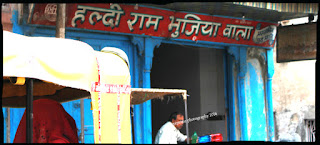Chasing Temples in the Capital of Mallabhum - 4
4 day trip including journey dates
By Moutushi Ghoshdeysarkar
Morning temple target was accomplished with ease; we went to the farthest first in a rickshaw(the three-wheeled two-seater vehicle that the puller pedals) to save time.
Set amidst the garden maintained by the Horticulture society which also houses many trees are the two ancient temples. The last one on the grounds lining the boundary is Kalachand temple. Some 20 people had gathered both men and women when we reached there and more were pouring in; not for worship but some meeting which involved distribution of money.
Adorning the entrance is the Radhamadhob temple. Its walls are sculpted with the story of Ramayana.
Walking back towards the town within a 100 mts is the Radha Gobinda temple. Distinguished I would say for the little structure beside it which creates a magical frame for portraits.
Further down is Nandalal temple and here is where we met a guard who has a rifle. He was there to protect the temples from vandals and petty gamblers.
Right opposite to Nandalal temple is the Jor Mandir, which is a conglomeration of 3 temples neatly tucked in a compound and this too has an armed guard. This compound is hardly 300 mts from the famous Chinnamasta temple.
We walked back to the tourist lodge, taking one last glance at the terracotta market, checked out, and drove off to Panchmura, this time in an Indica to my utter disappointment. The 22kms drive though is so delightful that I could make it in a tin van from our school days if required. The metalled road goes through a series of ‘Akashmoni’ plantation, commonly known as earleaf acacia, that is native to Australia, Indonesia and Papua New Guinea. It is used as fuel and for making furniture, paper and tools. It has medicinal uses too.
The plantations were interrupted by fields and ponds and small tribal villages. A tourism savvy state could have turned this drive into a money churner. There are no restrooms or eateries on the way.
A sudden congregation of people and cars almost midway in an otherwise deserted road elicited inquiry and revealed a curious info. It was an ashram, a little off the road, where people came from afar and near to find a cure for cancer. There was a basic eatery on the roadside and to our expectant glances driven by the stomach’s calls, our driver shook his head so fervently to convey a ‘no’ as if, even to look at the food would mean instant doom.
Panchmura is a usual village but for the housing of the unusual artists whose livelihood is to build these wonders with mud. Horse, elephant, bison, rhino, birds, masks, motifs on tiles, vase and so many small, medium, large and giant items. It is overwhelming.
Here again, our request for a stopover at a sweet shop was met with the same vehement shaking of head by our driver Malay. Yet having next to nothing for lunch was a small price to pay for the extraordinary experience that we bagged from the trip to Panchmura.
We reached the station well before time for the train. Bishnupur station is a neat affair; decorated with flowering plants and terracotta tiles, it has two platforms and a couple of tracks. The train got delayed and we got ample time to explore the small town beauty. It has 86 benches placed uniformly, first class and second class waiting rooms and retiring rooms too. The stalls were all closed.
The original plan was to drop in to a relatives place at Kharagpur, sort of midway, the station that boasts of the longest platform in Asia, and stay over for the night; instead, we changed it to just paying them a visit and de-boarded at the station.
To secure a train back home we went to counter to inquire about the last passenger train to Howrah and to our utter dismay found that it was due in a couple of minutes.
We rushed back to the platform got a somewhat empty passenger train where we could stand with our luggage and I started watching the co-passengers with great interest. These were people we call the mass. These were people we hardly interact with, in lieu of being able to do almost everything online. These were people who make the backbone of our country and yet are the most ignored except for the few days before elections.
There were hawkers selling almost every item that a household might need and savouries of all tastes. It is like a mini supermarket on the move only a class apart. Is it not so intriguing, how we humans have divided and subdivided into classes and subclasses depending on practically virtual notions?
The train was to terminate at a stop before Howrah, our destination. The first thing I did as we got down was to use the public washroom. The train had a toilet but it was unusable; for us.
Shortly we got another train and reached Howrah. We were famished and food was our top priority. I called dad to pick us up from 26 km afar and he did; a dad is someone you could always rely on. Remember calling my parents from Gulbarga while on a college trip and man! They did go to get me.
My little son was already asleep as we step into the home a little after 12. And that was how the beautiful 4 day Bishnupur trip came to an end.

















Comments
Post a Comment